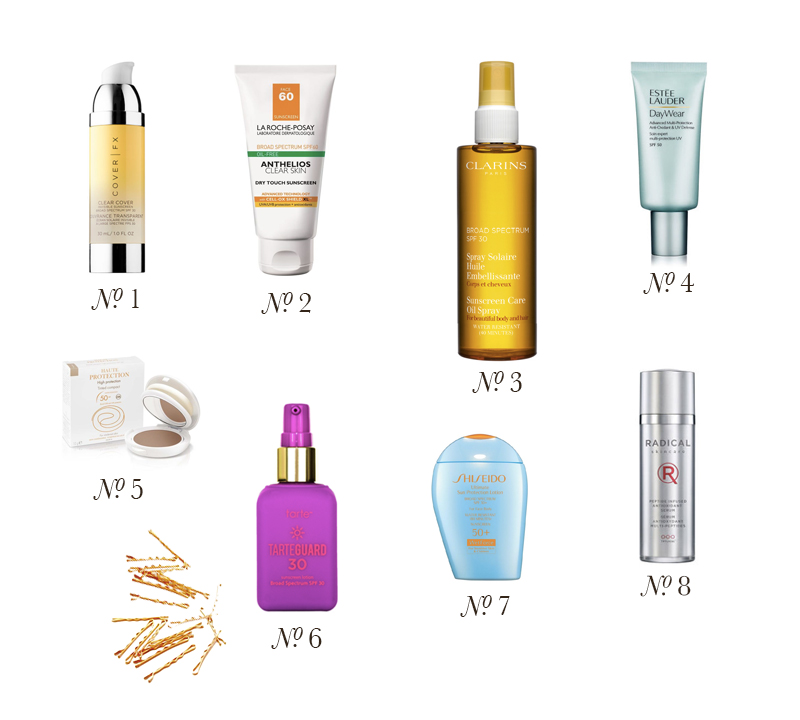
IT IS THE HEIGHT of summertime, which means long weekends, days at the beach and sunshine—so much beautiful, wonderful sunshine. Of course, along with the sun comes all the health & beauty precautions. To make things a little to decipher, here is a guide to SPF, antioxidants and sunscreen.
Sunlight is made up of two types of harmful rays that reach the earth: long wave ultraviolet (UVA) and short wave ultraviolet (UVB). Overexposure to either of these can lead to skin cancer. In addition, UVA rays can prematurely AGE your skin, causing wrinkles and age spots; they can also pass through glass. UVB rays on the other hand, are the primary cause of SUNBURN and can not pass through window glass.
Unfortunately, there is no safe way to tan, for every time you do, your skin becomes damaged. As this damage builds, you speed up the aging of your skin and increase your risk for all types of skin cancer. Therefore, you should use SUNSCREEN every day, summer to winter, if you plan to be outdoors, as the sun emits harmful UV rays all year round. Even on CLOUDY days, up to 80 percent of the sun’s UV rays can still penetrate your skin. Snow, sand, and water increase the need for sunscreen as they reflect the sun’s rays.
SPF
SPF or Sun Protection Factor refers to the theoretical amount of time you can stay in the sun without getting burned. For example, an SPF of 15 would allow you to stay in the sun 15 times longer than you could without protection. A common misunderstanding is that an SPF of 15 is only half as effective as an SPF of 30, when in actuality, the number refers how much UVB radiation the product will block. For instance, SPF 30 sunscreens block 96.7 percent of UVB radiation, while SPF 15 sunscreens block 93 percent. Anything higher than SPF 30, and the amount of extra protection from UVB rays is marginal—for instance, sunscreens with SPF 50 block 98 percent, while those with SPF 100 block 99 percent. For this reason, dermatologists recommend that an SPF 30 sunscreen should be sufficient.
It is also important to remember that high-number SPF sunscreens last the same amount of time as low-number—that is, a high-number SPF does not allow you to spend more time in the sun without reapplying. All sunscreens should be applied approximately every two hours or according to time on the label, even on cloudy days, and especially after swimming or sweating.

WHAT TO LOOK FOR WHEN BUYING SUNSCREEN
There are three things you should look for on the label: Broad-spectrum protection (protects against UVA and UVB rays — without the words “broad spectrum” the product will not likely offer coverage from UVA rays); an SPF of 30 or higher, and water resistance (Water Resistant means it is effective for up to 40 minutes in water and Very Water Resistant that it is effective for up to 80 minutes in water). You should still reapply after swimming or sweating.
Most active ingredients in sunscreen shield against UVB rays, but far fewer have UVA coverage, and only a small percentage offer both, so it’s important to search for BROAD-SPECTRUM products. Personally, we like sunscreens that contain the active ingredient zinc oxide, a natural sunscreen ingredient that physically (as opposed to chemically) blocks rays. Zinc oxide protects against both UVA and UVB rays.
Avoid products that have a Skin Cancer/Skin Aging Alert in the Drug Facts section of the label, meaning the sunscreen will only prevent sunburn and will not reduce the risk of skin cancer and early skin aging.
ANTIOXIDANTS
Unstable molecules in the skin produce OXIDANTS, also known as free radical; the body creates these to help fend off viruses and microbes. However, if your body produces too many oxidants, they can cause serious damage and contribute to certain cancers and heart disease. Exposure to sunlight, smoke and air pollution also produce oxidants. Antioxidants prevent or stop cell damage caused by oxidants.
Some sunscreens contain antioxidants, but it is believed that antioxidants in sunscreen are not effective, as antioxidant ingredients are unstable and do not work well when exposed to light and air. Even if the antioxidants in sunscreen do not oxidize, they become neutralized in SPF ingredients. Additionally, sunscreens actually produce free radicals; that is, chemical SPF ingredients like Avobenzone and Octinoxate produce free radicals when they absorb UV rays. To counteract this production, use an antioxidant serum underneath your sunscreen. Or, if you would like to avoid free radical-producing sunscreens altogether, opt for physical (mineral) sunscreen ingredients, like ZINC and TITANIUM DIOXIDE, and pair the sunscreen with an antioxidant serum.
There are other ways to increase the amount of antioxidants in the body: antioxidants can be found in fruits (such as BLUEBERRIES, raspberries and kiwis), vegetables (such as lycopene, found in tomatoes; also try red peppers and pumpkin), coffee, tea, wine (called resveratrol), and chocolate (called flavanols). Other popular antioxidants include vitamins A (beta-carotene), C, E, and catechins.
As it’s possible to have too many antioxidants, which suppress your body’s own ability to turn on its antioxidant defense system, it’s better to eat antioxidant-rich foods rather than take supplements—it’s difficult to get too much from your diet. You can also layer an antioxidant serum on your face under sunscreen, as well as an antioxidant-infused body lotion. Below are a few other products to try . . .

№ 01 – Cover FX Clear Cover Invisible Broad-Spectrum Sunscreen SPF 30 / № 02 – LaRoche Posay Anthelios Clear Skin SPF 60 / № 03 – Clarins Sunscreen Care Oil Spray SPF 30 / № 04 – DayWear Advanced Multi-Protection Anti-Oxidant & UV Defense Broad Spectrum SPF 50 / №05 – AVÈNE High Protection Tinted Compact SPF 50 / № 06 – Tarte TarteGuard 30 Sunscreen Lotion Broad Spectrum SPF 30 / №07 – Shiseido Ultimate Sun Protection Lotion WetForce for Sensitive Skin and Children SPF 50+ / № 08 – Radical Skincare Advanced Peptide Antioxidant Serum
